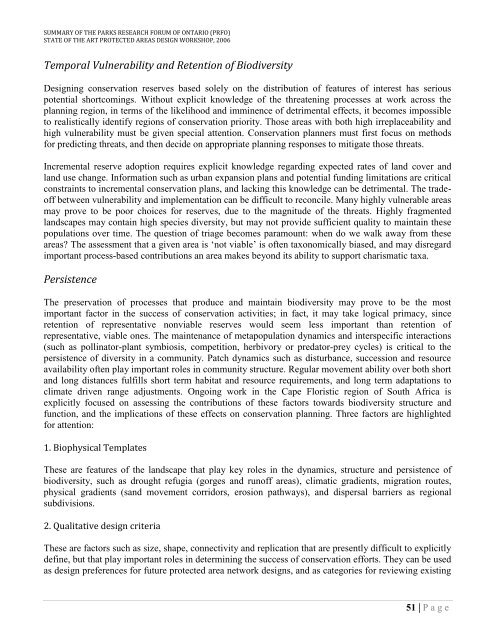Top-Down vs. Bottom Up: Working Towards Consensus ... - CASIOPA
Top-Down vs. Bottom Up: Working Towards Consensus ... - CASIOPA
Top-Down vs. Bottom Up: Working Towards Consensus ... - CASIOPA
- No tags were found...
Create successful ePaper yourself
Turn your PDF publications into a flip-book with our unique Google optimized e-Paper software.
SUMMARY OF THE PARKS RESEARCH FORUM OF ONTARIO (PRFO)STATE OF THE ART PROTECTED AREAS DESIGN WORKSHOP, 2006Temporal Vulnerability and Retention of BiodiversityDesigning conservation reserves based solely on the distribution of features of interest has seriouspotential shortcomings. Without explicit knowledge of the threatening processes at work across theplanning region, in terms of the likelihood and imminence of detrimental effects, it becomes impossibleto realistically identify regions of conservation priority. Those areas with both high irreplaceability andhigh vulnerability must be given special attention. Conservation planners must first focus on methodsfor predicting threats, and then decide on appropriate planning responses to mitigate those threats.Incremental reserve adoption requires explicit knowledge regarding expected rates of land cover andland use change. Information such as urban expansion plans and potential funding limitations are criticalconstraints to incremental conservation plans, and lacking this knowledge can be detrimental. The tradeoffbetween vulnerability and implementation can be difficult to reconcile. Many highly vulnerable areasmay prove to be poor choices for reserves, due to the magnitude of the threats. Highly fragmentedlandscapes may contain high species diversity, but may not provide sufficient quality to maintain thesepopulations over time. The question of triage becomes paramount: when do we walk away from theseareas? The assessment that a given area is „not viable‟ is often taxonomically biased, and may disregardimportant process-based contributions an area makes beyond its ability to support charismatic taxa.PersistenceThe preservation of processes that produce and maintain biodiversity may prove to be the mostimportant factor in the success of conservation activities; in fact, it may take logical primacy, sinceretention of representative nonviable reserves would seem less important than retention ofrepresentative, viable ones. The maintenance of metapopulation dynamics and interspecific interactions(such as pollinator-plant symbiosis, competition, herbivory or predator-prey cycles) is critical to thepersistence of diversity in a community. Patch dynamics such as disturbance, succession and resourceavailability often play important roles in community structure. Regular movement ability over both shortand long distances fulfills short term habitat and resource requirements, and long term adaptations toclimate driven range adjustments. Ongoing work in the Cape Floristic region of South Africa isexplicitly focused on assessing the contributions of these factors towards biodiversity structure andfunction, and the implications of these effects on conservation planning. Three factors are highlightedfor attention:1. Biophysical TemplatesThese are features of the landscape that play key roles in the dynamics, structure and persistence ofbiodiversity, such as drought refugia (gorges and runoff areas), climatic gradients, migration routes,physical gradients (sand movement corridors, erosion pathways), and dispersal barriers as regionalsubdivisions.2. Qualitative design criteriaThese are factors such as size, shape, connectivity and replication that are presently difficult to explicitlydefine, but that play important roles in determining the success of conservation efforts. They can be usedas design preferences for future protected area network designs, and as categories for reviewing existing51 | P a g e


